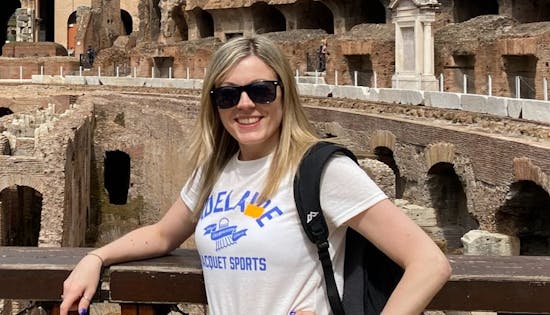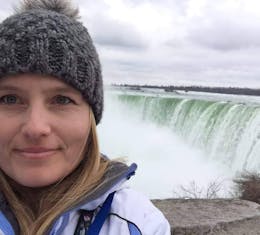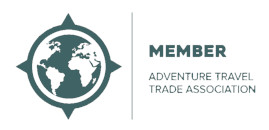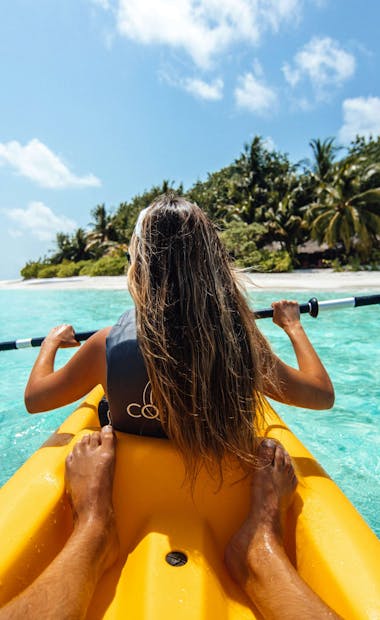Everest Base Camp Treks
Trek to Everest Base Camp through glaciers, forests and epic mountain backdrops
Popular tours
- Save8%
 View Tour
View TourEverest Base Camp Trek All Inclusive - 14 Days
- Kathmandu to Kathmandu
- Age group: 14 - 99
- Max group size: 12
Was:£1,370From£1,267 - Save6%
 View Tour
View TourEverest Trek & Overnight at Base Camp - 17 Days
- Kathmandu to Kathmandu
- Age group: 18 - 99
- Max group size: 12
Was:£1,741From£1,632 - Save8%
 View Tour
View TourIsland Peak Climbing & Everest Base Camp Trek - 18 Days
- Kathmandu to Kathmandu
- Age group: 18 - 99
- Max group size: 10
Was:£2,383From£2,204 - Save9%
 View Tour
View TourWomen's Everest Base Camp Trek (Inc Food) - 14 Days
- Kathmandu to Kathmandu
- Age group: 18 - 80
- Max group size: 10
Was:£1,304From£1,186 - Save7%
 View Tour
View TourEverest Base Camp Heli Trek - 11 Days
- Kathmandu to Kathmandu
- Age group: 18 - 99
- Max group size: 10
Was:£3,115From£2,882 - Save7%
 View Tour
View TourFamily Everest Base Camp Trek - 20 Days
- Kathmandu to Kathmandu
- Age group: 14 - 90
- Max group size: 18
Was:£1,775From£1,642
Everest Base Camp Treks
Welcome to The Adventure People, your trusted partner for unforgettable trekking experiences. If you're seeking a remarkable journey that combines breath-taking landscapes, rich culture, and a sense of accomplishment, look no further than the Everest Base Camp trek. Prepare to set foot in the majestic Himalayas, where towering peaks and awe-inspiring vistas await.
The Everest Base Camp trek is a bucket-list adventure that takes you to the foot of the world's highest peak, Mount Everest (8,848 meters / 29,029 feet). This iconic trek offers an opportunity to walk in the footsteps of legendary mountaineers and experience the unique Sherpa culture of the Khumbu region.
Highlights of the Everest Base Camp Trek:
Stunning Scenery: Immerse yourself in the beauty of the Himalayas as you traverse through picturesque valleys, alpine forests, and rugged mountain trails. Marvel at panoramic vistas of snow-capped peaks, including Everest, Lhotse, Nuptse, Ama Dablam, and many others.
Sherpa Culture and Hospitality: Interact with the warm-hearted Sherpa people, renowned for their mountaineering expertise and hospitality. Visit traditional villages, monasteries, and immerse yourself in their rich Buddhist traditions.
Namche Bazaar: Discover the bustling Sherpa hub of Namche Bazaar, a vibrant town nestled in the heart of the Khumbu region. Explore local markets, taste traditional cuisine, and learn about Sherpa history and culture.
Tengboche Monastery: Pay a visit to the sacred Tengboche Monastery, one of the most significant spiritual centers in the Everest region. Experience a moment of serenity and witness captivating Buddhist ceremonies amidst a stunning mountain backdrop.
Everest Base Camp: Reach the legendary Everest Base Camp, the launching point for mountaineers embarking on their summit attempts. Stand in awe of the surrounding Himalayan giants and share the excitement of being at the base of the world's highest peak.
Trekking to Everest Base Camp is a challenging adventure that requires a good level of physical fitness and mental endurance. Regular cardiovascular exercises, strength training, and hiking practice are recommended to prepare for the demands of the trek. Prior trekking experience is beneficial but not essential.
The prime seasons for the Everest Base Camp trek are spring (March to May) and autumn (September to November). These months offer stable weather conditions, clear skies, and moderate temperatures, providing ideal trekking conditions. However, with proper preparation and the right equipment, the trek can be undertaken during other months as well.
At The Adventure People we specialise in guided small group treks to Everest Base Camp. Experienced guides and Sherpa staff ensure your safety, provide expert guidance, and enhance your cultural experience. Each itinerary is carefully planned to allow for acclimatisation and maximize your chances of reaching Everest Base Camp successfully.
Trekking packages include comprehensive information on the necessary equipment and gear. You'll need sturdy trekking boots, layered clothing suitable for different weather conditions, a backpack, a sleeping bag, trekking poles, and other essential items. We can also assist with gear rental if needed.
Trekking to Everest Base Camp is a life-changing experience that rewards you with a sense of accomplishment and a profound connection to nature. Let The Adventure People be your trusted companion on this extraordinary adventure, ensuring your safety, comfort, and memorable moments throughout the journey.
Contact us today to start planning your Everest Base Camp trek. Let us guide you!
What is the best time to do the Everest Base Camp Trek?
The best time to trek to Everest Base Camp is during the spring (March to May) and autumn (September to November) seasons. During these months, the weather is generally clear and dry, and the temperatures are mild, making it ideal for trekking.
In the spring season, the skies are clear, and the mountain views are stunning. The temperatures are relatively mild, with daytime temperatures reaching around 10-15°C at lower altitudes. However, this season can be quite crowded, with many trekkers and climbers attempting to summit Mount Everest.
In the autumn season, the skies are clear, and the temperatures are cool and stable. The trails are less crowded, and the mountain views are still stunning. Temperatures during the day are usually around 10°C, but can drop below freezing at night, especially at higher altitudes.
It is important to note that weather patterns can be unpredictable, and conditions can change quickly in the mountains. Therefore, it is essential to be well-prepared and to check weather reports regularly before embarking on a trek to Everest Base Camp.
Am I fit enough for the Everest Base Camp Trek?
To fully enjoy and successfully complete the Everest Base Camp trek, it is important to have a good level of physical fitness and stamina. The trek involves long days of walking on varied terrain and gaining significant altitude. Here are some key considerations regarding fitness for the Everest Base Camp trek:
Cardiovascular Fitness: Building cardiovascular endurance is crucial as the trek involves walking for several hours each day. Engage in activities such as jogging, cycling, swimming, or brisk walking to improve your cardiovascular fitness.
Strength and Endurance: Strengthening your leg muscles, core, and upper body will help you navigate the challenging terrain and carry your backpack comfortably. Incorporate exercises such as squats, lunges, planks, push-ups, and weight training into your fitness routine.
Trekking Practice: Prioritize practicing trekking with a loaded backpack to simulate the conditions of the trek. Gradually increase the weight of your backpack and go on long hikes or hill walks to prepare your body for the demands of the trek.
Altitude Training: As you ascend to higher altitudes during the trek, the reduced oxygen levels can be challenging. Consider incorporating altitude training techniques, such as hiking at higher elevations or using simulated altitude training devices, to help your body acclimatize better.
Mental Preparation: Trekking to Everest Base Camp can be mentally demanding. Prepare yourself mentally for long days of walking, changing weather conditions, and potential altitude-related challenges. Develop a positive mindset, determination, and mental resilience to overcome any obstacles.
It's important to consult with your healthcare provider before embarking on any strenuous physical activity, especially if you have any pre-existing medical conditions. They can provide personalized advice based on your health status and recommend any necessary precautions.
Remember, the more prepared you are physically and mentally, the more you'll be able to enjoy the incredible experience of trekking to Everest Base Camp. Start your training well in advance to give yourself enough time to build fitness and endurance before the trek.
Here is our guide on how fit you need to be to trek to Everest Base Camp.
What are the distances covered during Everest Base Camp treks?
The distances covered on Everest Base Camp treks can vary depending on the specific route, side trips, and itinerary. Here are approximate distances for the standard Everest Base Camp trek from Lukla to Everest Base Camp and back:
Lukla to Phakding: The trek usually begins with a flight from Kathmandu to Lukla. From Lukla, you'll trek approximately 9 kilometres (5.6 miles) to Phakding, which takes around 3-4 hours.
Phakding to Namche Bazaar: The trek from Phakding to Namche Bazaar is approximately 13 kilometres (8 miles) and takes around 6-7 hours. This section involves crossing suspension bridges and ascending gradually along the Dudh Koshi River.
Acclimatization Day in Namche Bazaar: While not a long-distance trek, this day is dedicated to acclimatization. You can explore the surroundings, hike to higher elevations for better acclimatization, or visit nearby attractions such as the Everest View Hotel or the Sherpa Cultural Museum.
Namche Bazaar to Tengboche: The trek from Namche Bazaar to Tengboche covers a distance of around 10 kilometres (6.2 miles) and takes approximately 5-6 hours. The trail offers stunning views of Everest, Lhotse, and Ama Dablam as you hike through rhododendron forests.
Tengboche to Dingboche: The trek from Tengboche to Dingboche is approximately 11 kilometres (6.8 miles) and takes around 5-6 hours. You'll pass through picturesque villages, cross suspension bridges, and experience a change in the landscape as you ascend higher.
Acclimatization Day in Dingboche: Similar to Namche Bazaar, a day is dedicated to acclimatization in Dingboche. You can take short hikes to higher altitudes or explore the village and its surroundings.
Dingboche to Lobuche: The trek from Dingboche to Lobuche covers a distance of approximately 11 kilometres (6.8 miles) and takes around 5-6 hours. The trail gradually ascends, and you'll start noticing the rugged and barren landscape of the Khumbu region.
Lobuche to Everest Base Camp (via Gorak Shep): The trek from Lobuche to Everest Base Camp is approximately 15 kilometres (9.3 miles) and takes around 8-9 hours. The final leg of the trek is challenging, with rocky terrain and higher altitudes. You'll reach Everest Base Camp, situated at an elevation of about 5,364 meters (17,598 feet).
Please note that these distances are approximate and can vary depending on the specific route, side trips, and variations in itineraries offered by different trekking agencies. It's always advisable to check with your trekking agency or guide for the exact distances and itinerary details.
How much money should I take on an Everest Base Camp Trek?
The official currency of Nepal is the Nepali rupee (NPR) which you can't buy outside the country so taking some cash in a major currency to exchange on arrival and your bank cards is best. We suggest USD as it is also often accepted in Nepal. When in Nepal though you can use Nepalese Rupee which you acquire from cash machines. Nepalese Rupee (NRP) is widely used throughout Kathmandu and along the trek.
When planning for an Everest Base Camp trek, it's essential to consider your budget and ensure you have enough funds to cover various expenses along the way. Here are some key aspects to consider when determining how much money to take on your trek:
Trekking Package: The cost of your trekking package will typically include accommodation, meals, guide and porter services, permits, and transportation. The prices can vary depending on the duration of the trek, the level of comfort, and the inclusions provided by the trekking agency. Research and compare different agencies to find one that fits your budget and offers the services you require.
Flights and Transportation: If you're traveling from outside Nepal, factor in the cost of international flights to Kathmandu, as well as domestic flights from Kathmandu to Lukla (the starting point of the trek) and back. Additionally, consider the cost of transportation from the airport to your accommodation in Kathmandu.
Visas and Permits: Obtain a Nepali tourist visa upon arrival in Kathmandu, which incurs a fee depending on the duration of your stay. You'll also need to obtain permits for the Everest region, such as the Sagarmatha National Park Permit and the TIMS (Trekkers' Information Management System) Card. Be sure to budget for these permit fees.
Accommodation and Meals in Kathmandu: Before and after the trek, you'll need accommodation and meals in Kathmandu. The cost can vary depending on the level of comfort you choose and your preferences for dining. Budget accommodation and local eateries can help keep costs down.
Additional Expenses: Consider additional expenses such as travel insurance (which is highly recommended), equipment and gear purchase or rental, snacks and drinks along the trek, hot showers, charging electronic devices, and tipping your guides and porters.
It's challenging to provide an exact figure as expenses can vary based on personal preferences, the duration of your stay in Kathmandu, and your spending habits. As a rough estimate, a typical Everest Base Camp trek can cost anywhere from $1,500 to $3,000 or more, depending on the factors mentioned above.
It's wise to carry a combination of cash (preferably in Nepalese rupees) and a debit or credit card for backup. ATMs are available in Kathmandu, but their availability decreases as you trek higher. Cash is commonly used for small purchases along the trek, while cards are more convenient for larger expenses and accommodations in Kathmandu.
Remember to check the currency exchange rates, inform your bank about your travel plans to avoid any card issues, and keep your money and valuables secure during the trek.
Consult with your trekking agency or research online for more specific cost information and budgeting tips.
What should I pack for my Everest Base Camp trek?
Packing appropriately for your Everest Base Camp trek is crucial to ensure your comfort, safety, and enjoyment throughout the journey. Here is a comprehensive list of essential items to pack:
Clothing:
- Base Layers: Moisture-wicking and quick-drying tops and bottoms to regulate body temperature.
- Insulating Layers: Fleece jackets, down jackets, or synthetic insulated jackets for warmth in cold conditions.
- Outer Shell Jacket: A waterproof and windproof jacket to protect against rain and snow.
- Trekking Pants: Lightweight, quick-drying pants with zip-off legs or thermal leggings for layering.
- T-shirts and Long-sleeve Shirts: Breathable and lightweight tops for layering.
- Underwear and Socks: Moisture-wicking, quick-drying underwear and comfortable trekking socks (bring extra pairs).
- Headwear: Warm beanie or hat, sun hat, and buff or neck gaiter for protection from the elements.
- Footwear: Trekking Boots: Sturdy, comfortable, and waterproof boots with ankle support for challenging terrain.
- Hiking Shoes/Sandals: Lightweight footwear for wearing in and around the teahouses/campsites.
- Socks: Moisture-wicking and cushioned trekking socks (bring extra pairs).
- Backpack: A comfortable backpack with a capacity of 30-40 litres to carry your essentials.
- Sleeping Bag: A warm and lightweight sleeping bag suitable for sub-zero temperatures.
- Trekking Poles: Adjustable trekking poles for stability and reducing strain on your knees.
- Headlamp: A reliable headlamp with extra batteries for early morning or night-time hikes.
- Water Bottle: A reusable water bottle or hydration system to stay hydrated throughout the trek.
- Sunglasses: UV-protective sunglasses with good coverage to shield your eyes from the sun and snow.
- Sunscreen and Lip Balm: High SPF sunscreen and lip balm to protect against strong UV rays.
- First Aid Kit: Essential medical supplies, including bandages, antiseptic cream, painkillers, and altitude sickness medication.
- Toiletries: Toothbrush, toothpaste, biodegradable soap, hand sanitizer, wet wipes, and toilet paper.
- Quick-dry Towel: Lightweight and compact towel for personal hygiene.
- Snacks and Energy Bars: High-energy snacks to keep you fuelled during the trek.
- Cash and Travel Documents: Carry Nepalese currency (rupees), your passport, permits, travel insurance documents, and photocopies.
- Electronics: Camera, spare batteries, charging cables, and travel adapters.
- Trekking Map/Guidebook: A reliable trekking map or guidebook for reference.
- Entertainment: Books, cards, or other forms of entertainment for downtime at teahouses.
Remember to pack light, prioritize essential items, and avoid overpacking. Keep in mind the weight limits set by your trekking agency and the limited space available on the trek. Also, dress in layers to adapt to changing weather conditions and temperatures during the trek.
It's advisable to consult with your trekking agency for a detailed packing list specific to the Everest Base Camp trek. They can provide additional guidance based on the time of year you'll be trekking and any specific requirements you may have.
Is luggage transported each day on Everest Base Camp treks?
On most guided Everest Base Camp treks, your main luggage or duffel bag is transported by porters or yaks between the teahouses or campsites. This allows you to trek with a lighter daypack carrying only your essentials for the day. It's important to note the following details regarding luggage transport:
Weight Limit: There is usually a weight limit for the luggage that can be transported by porters or yaks, typically around 10-15 kilograms (22-33 pounds) per person. Excess luggage may incur additional charges or require an extra porter.
Duffel Bags: It is recommended to use a sturdy duffel bag to pack your main luggage. Avoid using suitcases or hard-shell bags as they are not suitable for transport by porters or yaks.
Separation of Luggage: Before the trek, you will need to pack your main luggage and separate the items you won't need during the trek. These items can be stored securely at your hotel or with your trekking agency in Kathmandu. This ensures that you only take necessary items on the trek.
Daypack: You will need a comfortable daypack to carry your essentials for each day, including water, snacks, extra layers, camera, sunscreen, and other personal items.
Valuables: It's advisable to carry your important documents, money, electronics, and other valuable items in your daypack, as you'll have it with you at all times.
It's important to pack your main luggage efficiently and keep it organized. Place any items you may need during the trek in a separate small bag within your duffel bag for easy access.
While luggage transport is generally available on guided Everest Base Camp treks, it's recommended to check with your trekking agency or tour operator for specific details about their services and any restrictions that may apply.
Tell me about the Women's Everest Base Camp Trek
This is an exclusive Women's Only trek created for The Adventure People from our Preferred Partner. Everest Base Camp Trek is a dream destination for trekkers around the world. And why wouldn’t it be? This 14 day trek will be led by a female trekking leader guiding you through lovely Sherpa villages to the classic trekking trails found nowhere else. Let's not forget the obvious, the famed Himalayas and the world’s highest mountain, Mt. Everest!
With this tour you'll also be supporting our Preferred Partner with getting more women in Nepal to become female trekking leaders. In Nepal, being a female trekking leader isn't considered the stereotypical role for a women, meaning less and less women want to become one. The Adventure People and our Partner are working towards changing this, by donating 5% of the tour cost in training more women to become a trekking leader!
How many people are in each group trekking to Everest Base Camp?
The group size for treks to Everest Base Campcan vary depending on the trekking agency or tour operator, as well as the time of year and demand. However, the typical group size ranges from 6 to 12 participants.Smaller group sizes often allow for a more personalized experience, closer interaction with the guide, and better opportunities for group dynamics. It also enables the guide to provide individual attention and support to each trekker.
On the other hand, larger group sizes may offer a more social experience with a diverse group of fellow trekkers. However, it's important to note that larger groups can be more challenging to manage and may require additional coordination and resources.
When choosing a trekking agency or tour operator, consider your personal preferences for group size and the level of individual attention you desire. Some agencies may specialize in smaller group treks, while others may cater to larger groups. It's advisable to inquire about the group size when booking your trek to ensure it aligns with your expectations and preferences.
Regardless of the group size, trekking to Everest Base Camp offers a unique opportunity to connect with fellow trekkers from different parts of the world, share experiences, and create lasting memories together.
Are any treks to Everest Base Camp suitable for children?
Trekking to Everest Base Camp is a physically demanding and challenging adventure that involves high altitudes, long hours of walking, and unpredictable weather conditions. Therefore, it is generally not recommended for young children, especially those under the age of 12.
The main reasons why Everest Base Camp treks may not be suitable for young children are:
Physical Demands: The trek involves long and strenuous daily walks, steep ascents and descents, and challenging terrain. Children may not have the physical stamina and strength required to endure the trek.
Altitude Considerations: The high altitude along the Everest Base Camp trek presents the risk of altitude-related illnesses such as Acute Mountain Sickness (AMS). Children are more susceptible to altitude sickness due to their developing bodies and may have difficulty acclimatizing properly.
Safety Concerns: The trek involves rugged paths, narrow trails, and potentially hazardous sections. Children may lack the necessary balance, coordination, and judgment skills to navigate these terrains safely.
However, if you are considering trekking to Everest Base Camp with older children or teenagers, it is crucial to assess their fitness levels, previous trekking experience, and ability to adapt to high altitudes. It's recommended to consult with experienced trekking agencies or tour operators who can provide guidance on age restrictions and assess the suitability of the trek for children.
Alternatively, there are other trekking options in the Everest region that are more family-friendly, such as shorter treks to destinations like Tengboche or Namche Bazaar, which offer stunning views and a taste of the Everest experience without the full intensity of the Everest Base Camp trek.
Ultimately, the safety and well-being of your children should be the top priority. Careful consideration, proper preparation, and consultation with experts will help determine the best trekking options for your family.
Are there alternative routes to Everest Base Camp?
If you have a little longer we have some incredible routes that give you the chance to experience the area and take a more scenic route.
We have a wide range of options covering circular routes (all the above are linear) so just ask if this is of interest! Our most popular is the Gokyo Lakes circuit, which goes through some of the most stunning scenery in the Himalaya (and surely the world). These are more experienced trekkers - get in touch if you are unsure!
Can I prevent Altitude sickness on Everest Base Camp treks?
Preventing altitude sickness is essential when trekking to high altitude destinations like Everest Base Camp. You can take measures which may help with altitude sickness. The best and most effective way is acclimatisation. This means taking your time and getting used to the oxygen levels.
Arriving in Kathmandu a couple of days early will help. During he trek it's important not to go too quickly and to really be in tune with your body, resting as and when needs be.
Here are some tips to help prevent altitude sickness:
Ascend gradually: Give your body time to acclimatise by ascending slowly and allowing for rest days. A common rule of thumb is to not ascend more than 300-500 meters per day above 3,000 meters.
Stay hydrated: Drink plenty of fluids, including water, herbal tea, and soup. Avoid alcohol, caffeine, and sugary drinks, as these can dehydrate you.
Eat well: Maintain a balanced diet that includes complex carbohydrates, proteins, and fats. Avoid heavy, fatty, or greasy foods that are difficult to digest.
Consider medication: Talk to your doctor about prescription medications, which can help prevent and treat altitude sickness.
Listen to your body: Pay attention to any symptoms of altitude sickness, such as headache, nausea, dizziness, or shortness of breath. If you experience these symptoms, rest and descend to a lower altitude.
Stay warm and dry: Dress in layers and wear waterproof clothing to stay warm and dry. Hypothermia and frostbite are real dangers at high altitude.
Avoid overexertion: Pace yourself and avoid overexertion. Take breaks when needed and avoid strenuous exercise or activities that require a lot of energy.
Remember, preventing altitude sickness is essential for your safety and enjoyment of the trek. Always prioritize your health and listen to your body.
What is the food like on Everest Base Camp treks?
During Everest Base Camp treks, you can expect a variety of meals that are designed to provide the necessary nutrition and energy for your trekking journey. The food offered along the trail is primarily served in teahouses or lodges, which are basic guesthouses catering to trekkers. Here's an overview of the food you can expect during your Everest Base Camp trek:
Breakfast: Breakfast typically includes a combination of Western and Nepalese options. You can expect items such as toast, eggs (cooked to order), pancakes, porridge, muesli, and tea or coffee. It's a substantial meal to kick-start your day.
Lunch: Lunch is usually a break during the trek, and it consists of a variety of options such as soups, sandwiches, momos (Nepalese dumplings), pasta, rice dishes, or fried noodles. These meals provide the necessary energy to fuel you for the afternoon trek.
Dinner: Dinner is a more extensive meal, offering a range of dishes including Nepalese, Tibetan, Indian, and Western cuisine. Common dinner options include dal bhat (Nepalese lentil soup with rice), curries, noodles, pasta, stir-fried vegetables, momos, or pizza. Some teahouses also offer meat dishes such as yak stew or chicken curry. Vegetarian options are readily available.
Snacks and Refreshments: Along the trail, you'll find small shops where you can purchase snacks like chocolate bars, energy bars, cookies, nuts, and soft drinks. It's advisable to carry some of these snacks with you to have during the trek.
While the food is generally safe and prepared hygienically in teahouses, it's important to remember that the facilities along the trail are basic. The availability of certain ingredients and variety of dishes may vary depending on the location and altitude. Vegetarian options are generally more readily available than meat options.
It's also recommended to stay hydrated during the trek, so drink plenty of fluids, including boiled or treated water, tea, coffee, and hot chocolate. It's advisable to avoid consuming tap water and uncooked or unpeeled fruits and vegetables to minimize the risk of gastrointestinal issues.
If you have specific dietary requirements or restrictions, such as gluten-free, vegan, or allergies, it's essential to inform your trekking agency or tour operator in advance. They can communicate your dietary needs to the teahouses and make necessary arrangements to accommodate your requirements to the best of their ability.
Overall, while the food on Everest Base Camp treks may not be gourmet, it is nourishing, hearty, and provides the sustenance needed for your trekking adventure.
Can I get fresh water on my Everest Base Camp trek?
Yes, you can access fresh water on your Everest Base Camp trek. Along the trail, there are several sources of water where you can refill your water bottles or hydration packs. Here are some key points to consider regarding drinking water during your trek:
Bottled Water: It's not advisable to rely solely on bottled water as it contributes to plastic waste and is more expensive. However, bottled water is available for purchase at teahouses and shops along the trail if you prefer this option.
Filtered Water: Many teahouses and lodges provide filtered or purified water for trekkers. They use various methods such as boiling, ultraviolet (UV) treatment, or water filters to make the water safe for consumption. You can refill your water bottles at these locations. Be sure to confirm with your guide or teahouse owner about the water source and filtration method they use.
Water Purification Tablets or Sterilizers: It's a good idea to carry water purification tablets or a portable water sterilizer as a backup. These methods can be used to treat water from natural sources such as streams or taps to make it safe for drinking.
Hydration Bladders or Water Bottles: It's recommended to carry a reusable water bottle or a hydration bladder with a capacity of at least 2 litres. This will ensure you have an adequate water supply between water stations.
Avoid Tap Water: It's important to note that tap water along the trail is not considered safe for drinking. It's best to treat or purify the water before consumption.
Staying hydrated is crucial during the trek to prevent altitude-related illnesses and maintain your energy levels. Remember to drink plenty of water throughout the day, especially when hiking at higher altitudes. It's advisable to drink at least 3-4 litres of water per day to stay properly hydrated.
As a responsible trekker, try to minimize plastic waste by using refillable water bottles and purifying water from reliable sources. This helps preserve the environment and reduce the impact on the fragile ecosystems of the Everest region.
It's always recommended to consult with your trekking agency or tour operator for specific guidance on drinking water sources and practices during your Everest Base Camp trek. They will provide you with detailed information based on the current conditions and requirements of the trail.
Is there a Wifi signal on the Everest Base Camp trekking routes?
While there is limited availability of WiFi along the Everest Base Camp trekking routes, it's important to note that the quality and reliability of the signal can vary significantly. Here are some key points regarding WiFi access during the trek:
Teahouses and Lodges: Most teahouses and lodges along the Everest Base Camp trail offer WiFi services for a fee. However, it's important to set your expectations accordingly. The WiFi connection in these remote areas is often slow, unreliable, and may have limited coverage. Additionally, due to the high demand from trekkers, the connection speed may be slower during peak seasons.
WiFi Charges: In some teahouses, WiFi services are available for a small fee, which is usually based on usage time or data usage. The charges may vary from place to place, and it's advisable to check with the teahouse owner or your trekking agency for the specific details.
Connectivity Issues: Due to the mountainous terrain and remote location of the Everest Base Camp trek, there can be frequent disruptions or outages in the WiFi signal. Factors such as weather conditions, power supply, and technical limitations can impact the availability and stability of the connection.
Internet Cafes in Namche Bazaar: Namche Bazaar, one of the major towns along the Everest Base Camp trail, has a few internet cafes where you can access WiFi. These cafes provide better connectivity compared to the teahouses. However, it's important to note that the connection speed may still be slower compared to urban areas.
Offline Communication: Considering the limited availability and reliability of WiFi, it's advisable to inform your loved ones in advance about potential communication challenges during your trek. It's recommended to have alternative means of communication such as mobile networks, satellite phones, or other messaging apps that work offline.
While it can be convenient to have WiFi access during the trek, it's also an opportunity to disconnect from the digital world and immerse yourself in the natural beauty of the Himalayas. Embrace the experience of being in remote wilderness and connect with fellow trekkers and the stunning surroundings.
Remember to check with your trekking agency or tour operator for the most up-to-date information on WiFi availability along the Everest Base Camp trekking routes. They can provide specific guidance based on the current conditions and available facilities.
Is there a phone signal on Everest Base Camp trekking routes?
Along the Everest Base Camp trekking routes, there is limited mobile phone signal coverage. Here are some important points to consider regarding phone signal during the trek:
Mobile Network Coverage: The availability of mobile network coverage varies along the trekking routes. In the lower parts of the trail, particularly in towns and villages like Lukla and Namche Bazaar, you may find relatively better mobile signal reception. However, as you ascend to higher altitudes, the signal strength becomes weaker or may be completely unavailable.
Telecom Service Providers: The major telecom service providers in Nepal, such as Nepal Telecom and Ncell, have network coverage along some parts of the Everest Base Camp trail. However, it's important to note that the coverage is limited to specific areas, and there may be gaps in network availability.
Signal Strength and Reliability: Even in areas with mobile network coverage, the signal strength can be weak, intermittent, or unreliable. Factors such as the surrounding terrain, weather conditions, and distance from mobile towers can affect the quality of the signal.
Satellite Phones: In remote areas where there is no mobile network coverage, some trekking groups or guides may carry satellite phones for emergency communication. These satellite phones rely on satellite signals rather than terrestrial networks and can provide a means of communication in case of emergencies.
Local SIM Cards: If you wish to have a local mobile phone number and access mobile data during your trek, you can purchase a local SIM card from authorized sellers in Kathmandu or other major cities. However, it's important to check the network coverage of the specific service provider and understand that the signal strength may still be limited in certain areas along the trek.
It's worth noting that the primary purpose of trekking in the Everest region is to immerse yourself in nature and experience the stunning landscapes. Embrace the opportunity to disconnect from constant connectivity and enjoy the tranquillity of the Himalayas. However, for emergency communication or important updates, it's advisable to have alternative means such as satellite phones or designated communication devices.
Before your trek, it's recommended to check with your trekking agency or tour operator for the most up-to-date information on mobile phone signal availability and coverage along the Everest Base Camp trekking routes. They can provide specific guidance based on the current conditions and available facilities.
What kind of weather conditions can I expect during the trek?
Weather conditions during the Everest Base Camp trek can vary depending on the time of year and the altitude. Here's a general overview of the weather conditions you can expect during different seasons:
Spring (March to May):
- Mild temperatures at lower elevations, with average daytime temperatures ranging from 15°C to 20°C (59°F to 68°F).
- Warmer temperatures at higher elevations, with daytime temperatures ranging from 5°C to 15°C (41°F to 59°F).
- Generally clear skies and relatively stable weather.
- Possibility of occasional rainfall or snowfall, especially at higher altitudes.
- Increasing greenery and blooming rhododendrons along the trail.
Summer/Monsoon (June to August):
- Warmer temperatures at lower elevations, with average daytime temperatures ranging from 20°C to 25°C (68°F to 77°F).
- Cooler temperatures at higher elevations, with daytime temperatures ranging from 10°C to 20°C (50°F to 68°F).
- High humidity and increased chances of rainfall, especially during July and August.
- Frequent afternoon cloud cover and occasional heavy rain showers.
- Slippery trails and potential for leeches in lower sections.
Autumn (September to November):
- Mild temperatures at lower elevations, with average daytime temperatures ranging from 15°C to 20°C (59°F to 68°F).
- Cooler temperatures at higher elevations, with daytime temperatures ranging from 5°C to 15°C (41°F to 59°F).
- Generally clear skies and stable weather conditions.
- Stunning mountain views with excellent visibility.
- Dry season, making it an ideal time for trekking.
Winter (December to February):
- Cold temperatures throughout the trek, especially at higher elevations.
- Daytime temperatures can range from 0°C to 10°C (32°F to 50°F), but temperatures can drop significantly below freezing at night.
- Fewer trekkers on the trail, providing a quieter experience.
- Possibility of snowfall, especially at higher altitudes.
- Colder temperatures and icy trails require proper cold-weather gear and precautions.
It's important to note that weather conditions in the Everest region can be unpredictable, and they can change rapidly. Therefore, it's advisable to be prepared for varying weather conditions regardless of the season. It's recommended to check the weather forecast before your trek and consult with your trekking agency or guide for the most up-to-date information. Dressing in layers, carrying proper gear, and being flexible with your trekking itinerary can help you adapt to the changing weather conditions more comfortably.
Is altitude sickness common?
Altitude sickness, also known as acute mountain sickness (AMS), is a concern for trekkers on the Everest Base Camp trek due to the high altitude. Here are some key points about altitude sickness:
Prevalence: Altitude sickness is relatively common among trekkers in the Everest region. The risk increases as you ascend to higher altitudes, typically above 3,000 meters (9,800 feet).
Symptoms: Altitude sickness can manifest in various ways and can affect individuals differently. Common symptoms include headache, dizziness, nausea, loss of appetite, fatigue, shortness of breath, and trouble sleeping. In more severe cases, symptoms can escalate to high-altitude pulmonary edema (HAPE) or high-altitude cerebral edema (HACE), which require immediate medical attention.
Prevention: Adequate acclimatization is key to minimizing the risk of altitude sickness. This involves ascending gradually, allowing your body time to adapt to the decreasing oxygen levels. Taking regular rest days during the trek is essential. It is also recommended to stay hydrated, eat nutritious meals, avoid alcohol and smoking, and listen to your body's signals.
Medication: Some trekkers opt to take preventive medication to help with acclimatization. However, it is essential to consult with a medical professional before taking any medication and to be aware of potential side effects and contraindications.
Recognizing and Responding: If you experience symptoms of altitude sickness, it's crucial to take them seriously. Inform your trekking guide or team members immediately, as they are trained to assess and manage altitude-related issues. Descending to lower altitudes is often the most effective treatment for mild cases of altitude sickness.
Physical Fitness: Being physically fit does not guarantee immunity from altitude sickness. Even individuals who are in excellent physical condition can be susceptible to its effects. Proper acclimatization, hydration, and monitoring your body's response are more important factors for managing altitude-related challenges.
It's important to note that everyone responds differently to altitude, and there is no foolproof way to predict who will be affected. However, by trekking responsibly, allowing for proper acclimatization, and being aware of the symptoms and precautions associated with altitude sickness, you can minimize the risks and increase your chances of a safe and enjoyable trek to Everest Base Camp.
It is recommended to consult with your doctor or a travel medicine specialist before undertaking the Everest Base Camp trek to discuss your individual health conditions and any concerns related to altitude sickness.
Popular Everest Base Camp Treks
Guided Everest Base Camp Trek - 14 Days
Everest Trek with Overnight at Everest Base Camp - 17 Days
Women's Everest Base Camp Trek - 14 Days
Everest Base Camp and Gokyo Lakes Trek (inc food) - 18 days
Guided Everest Base Camp Trek (Inc Food) - 14 Days
Everest Three Pass Circuit - 20 Days
Everest Base Camp Short Trek (inc food) - 14 Days
Gokyo Lakes and Gokyo Ri Trek - 14 days
Everest Base Camp Heli Trek - 11 Days
Everest Base Camp Trek - 15 Days
Everest Base Camp & Gokyo Lakes Trek - 19 Days
Everest Base Camp & Annapurna Circuit Trek - 30 Days
Everest High Passes in Comfort - 22 Days
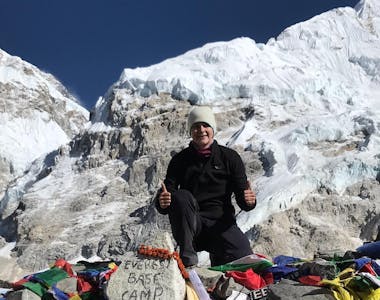
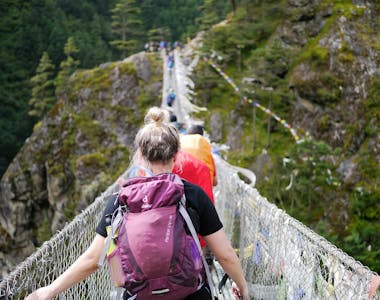




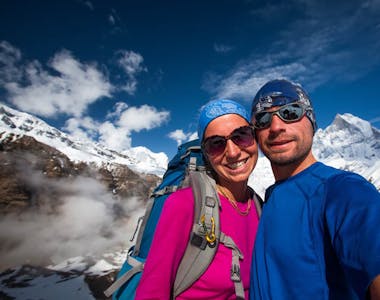

Book With Confidence
Monthly Payments
Spread the costs with no interest or additional fees
Best Price Guarantee
We won't be beaten on price. If you find this adventure at a lower price please get in touch!
Reserve now & pay later
Reserve your adventure today and pay later, free of charge
ATOL protected
Book with confidence
Hold your space today, for free
or book your trip with a deposit and then pay the rest in instalments.
Reserve your flights with us
Add flights to your booking and we'll take care of the rest. You'll get 24/7 support from our team & ATOL protection.
Speak to our experts
Call or email our expert team to find out more and help with ideas and planning.
